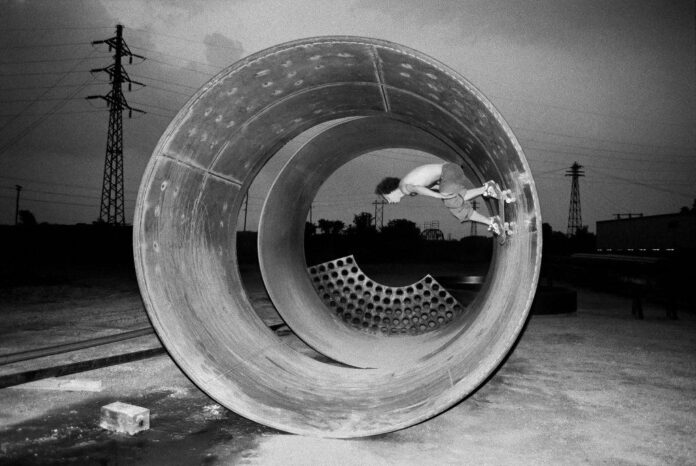Skateboarding, as seen through Ed Templeton’s photographs, has a life beyond the ramps. Yes, his high-impact images convey the spirit and kineticism of the sport, but so too has the photographer trained his lens on skateboarders behind the scenes and during their off-hours to preserve often raw and intimate moments.
These photographs, offering what Templeton called “a nice little hidden look” at a singular subculture, now make up his new exhibition at Bonnefanten Museum in Maastricht. Titled “Wires Crossed,” the show offers a view of and into the skateboarding life, as captured by Templeton from 1995 to 2012.
Across the exhibition are affectionate portraits of his fellow skateboarders, documents of injuries, snapshots of teenage hijinks, and of course, images of high-flying tricks—each of them a “memory trigger” for the photographer.

From (Aperture, 2023). Photo: © 2023 Ed Templeton
“While you’re hanging the show, the photos just become rectangles that you’re trying to fit into the space,” he told Artnet News. “But once they’re up, you have a little breathing room and you start really diving back into the images. And for me, each one takes me back to the place, the people, everything.”
Born in 1972 in California, Templeton was skating by the time he was 13 and turned pro before he’d even graduated from high school. In 1993, he launched his own skateboarding company, Toy Machine, which produces its own line of decks, wheels, and apparel, all printed with irreverent graphics, and sponsors a team of pro skateboarders that tours the country to spread the good word on the brand.
It was on one of these tours in 1994 that Templeton picked up a new trick: photography. “I had a mini epiphany that I should be shooting this,” he said. “Anthropologically, I just looked at it, like, ‘wow, this is an interesting group of people.’”

Ed Templeton, (2001), from (Aperture, 2023). Photo: © 2023 Ed Templeton
So began Templeton’s trove of photographs, shot with an edgy spontaneity to match their youthful subjects. Over the next few years, coming up as part of the street-art cohort known as the Beautiful Losers, he would go on to develop photographic series such as “Teenage Smokers” (2000) and “Teenage Kissers” (2011) that similarly leaned into an unfiltered aesthetic. He staged shows in galleries from New York to Tokyo; he released art books like 2008’s Deformer.
But it’s his colossal archive of photographs of young skateboarders at work and at play—”my giant, cantankerous body of work,” in his words—that he found “daunting” to tackle or organize. But, he added, “I knew I had something.”
He explained: “What we do is mostly hidden from the outside world. You see skateboarding tricks in magazines and videos, but you don’t really see behind the scenes and what the lifestyle is on a day-to-day basis.”

Ed Templeton, (2004), from (Aperture, 2023). Photo: © 2023 Ed Templeton
Templeton credits Lesley Martin, creative director of photography foundation Aperture, for wrangling context and meaning out of his skateboarding archive—”but still left the teeth on it.” The upshot of their collaboration isn’t just the Bonnefanten exhibition, but an accompanying monograph, also titled Wires Crossed, which includes interviews with some of the skaters in Templeton’s photos.
And the images in the exhibition and book, some never-before-seen, do retain their bite. There’s a kid popping a zit in a bathroom mirror, skater Billy Marks aiming a bow and arrow at a lampshade in a hotel room, and Tom Rowe showing off his back tattoo. Some skaters are caught in compromising positions; some others are pictured snoozing in sleeping bags spread haphazardly across a floor.

Ed Templeton, (1998), from (Aperture, 2023). Photo: © 2023 Ed Templeton
Templeton himself shows up too. In one image is his hand bloodied from a nasty gash yet defiantly flipping the bird; in another, his wife, artist Deanna Templeton, is pictured by his hospital bed, distraught after he was in another skateboarding accident (Templeton suffered amnesia from the mishap and does not remember taking this photo).
In all, Templeton is as much participant as he is observer—a remove, he said, that was down to his personality and him being pretty much the adult in the room. He’s married, and doesn’t drink or smoke. Plus, he added, “I was responsible for getting them to demos on time and making sure we could get up in the morning. I was more of a shepherd.”

Ed Templeton, (2008), from (Aperture, 2023). Photo: © 2023 Ed Templeton
A number of pictures in the series further bear painterly strokes and handwritten text the photographer has added in the style of Peter Beard or Jim Goldberg (Templeton is also a painter of wonderfully offbeat scenes). They give his black-and-white images a pop of color and texture, and the medium itself a handmade character.
“I don’t want to see a machine print that’s kind of cold,” Templeton said. “I like the idea of seeing something that was made in a dark room and has a wrinkle or something like that. It almost makes it ephemeral. When you write on it, the print itself is the object.”

From (Aperture, 2023). Photo: © 2023 Ed
Templeton
Such treatment, combined with Templeton’s perspective on the scene, transforms the body of work into more than a skateboarding showcase. “It’s a photography project; it’s not really for skateboarders,” said Templeton. “I hope to export what this lifestyle was like visually to people who might pick up the book or mosey in off the street into the museum.”
After all, it was not so long ago that photography too awoke something in him.
“It’s essentially a lifetime of work,” he added of Wires Crossed. “I’ve done a lot of other books before this one with my photography, but this is what started it all for me—what made me want to get into photography in the first place.”
Ed Templeton: Wires Crossed

























